
Penstemon barbatus, known by the common names golden-beard penstemon, and beardlip penstemon, is a flowering plant native to the western United States.

Penstemon azureus is a flowering plant species known by the common name azure penstemon. It is native to the mountains of Oregon and northern California. It grows in coniferous forests and woodlands in the Klamath Mountains, North California Coast Ranges, Southern Cascade Range, and Northern Sierra Nevada.

Penstemon caesius, commonly known as the San Bernardino penstemon, is a low growing species of flowering plant. It is endemic to California, where it is known from the San Bernardino and San Gabriel Mountains, as well as the southern mountains of the Sierra Nevada. It is a member of the flora on rocky slopes and in coniferous forests and alpine habitat in the mountains.

Penstemon cinicola is a species of penstemon known by the common name ash penstemon. It is native to northeastern California and southern Oregon, where it grows in forests and plateau habitat.
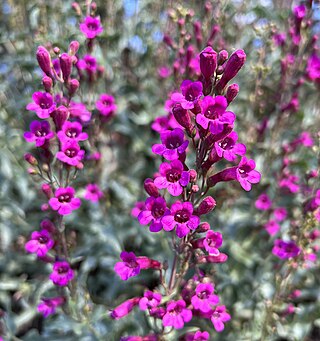
Penstemon clevelandii is a species of penstemon known by the common name Cleveland penstemon. It is native to southern California and Baja California, where it grows in mountain and desert habitat such as scrub, woodland, and chaparral.

Penstemon deustus is a species of penstemon known by the common names hotrock penstemon and scabland penstemon. It is native to much of the northwestern United States from the Pacific Northwest to Wyoming, where it grows in many types of forest and open plateau habitat, often on soils heavy in volcanic rock or on limestone outcrops.

Penstemon eatonii is a species of flowering plant in the genus Penstemon, known by the common name firecracker penstemon. It is native to the Western United States from Southern California to the Rocky Mountains. It grows in many types of desert, woodland, forest, and open plateau habitat.
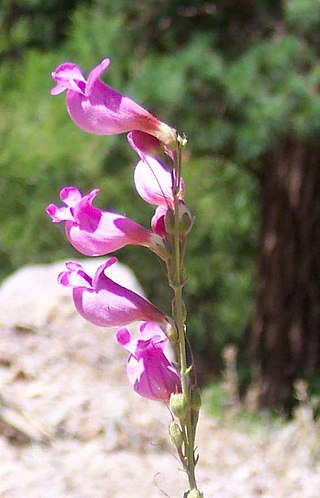
Penstemon floridus is a species of flowering plant in the plantain family known by the common names Panamint penstemon and rose penstemon.
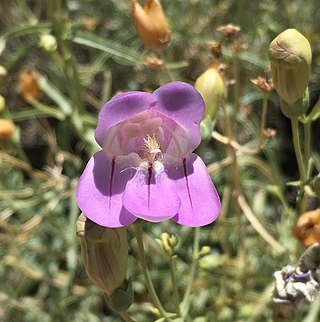
Penstemon fruticiformis is a species of penstemon known by the common name Death Valley penstemon. It is native to the western United States, where it is found growing in rocky scrub, woodlands, deserts and mountains of eastern California and western Nevada. It is known from scattered occurrences around Death Valley, and only one of the two varieties occurs on the Nevada side of the border.

Penstemon angustifolius is a perennial semi-evergreen forb belonging to the plantain family. This species is 1 out of roughly 273 species of Penstemon. This species is also known as broadbeard beardtongue. This forb is native to central United States and can be noticed by its brightly and highly variable colored flowers.

Penstemon cyaneus is a species of flowering plant in the plantain family known by the common names blue penstemon and dark blue penstemon. It is native to the western United States, where it is widespread in Idaho and also found in parts of Montana and Wyoming.
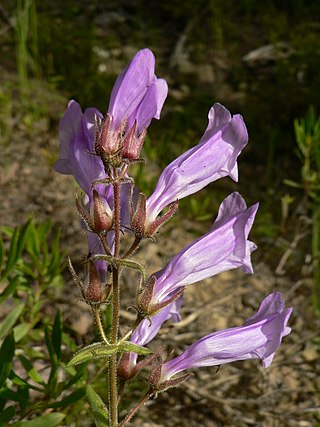
Penstemon fruticosus, the bush penstemon or shrubby penstemon, is a species of penstemon native to the Pacific Northwest of North America.

Penstemon davidsonii is a species of penstemon known by the common name Davidson's penstemon, honoring Dr. George Davidson. It is native to western North America.

Penstemon comarrhenus is a perennial plant in the plantain family (Plantaginaceae) found in the Colorado Plateau and Canyonlands region of the southwestern United States.
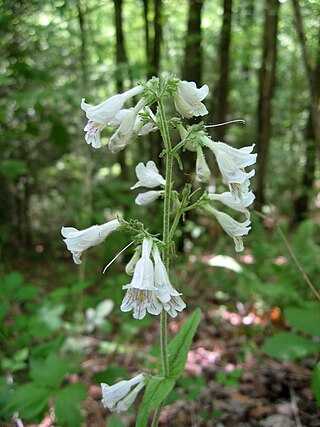
Penstemon brevisepalus, commonly known as short-sepaled beardtongue, is an herbaceous plant in the plantain family. It is a perennial that produces pale lavender flowers in late spring.

Penstemon calycosus, commonly called long-sepal beardtongue, is a species of plant in the plantain family (Plantaginaceae). It is native to eastern North America, where it native to the Upper South and Midwestern United States. It expanded its range into the northeast United States in the early 20th century. Its natural habitat is in open woodlands, prairies, and bluffs, often over limestone.

Penstemon gairdneri is a species of perennial plant in the Plantaginaceae family with the common name Gairdner's beardtongue. It is native to Washington, Oregon, and Idaho in the western United States.

Penstemon watsonii is a flowering plant that grows largely in Nevada, Utah, and Colorado. It grows in dry rocky areas and has blue to violet flowers.

Penstemon crandallii, also known as Crandall's penstemon, is a species of penstemon that grows in western Colorado and small parts of New Mexico and Utah. It is a low growing plant with blue to purple flowers.

Penstemon ophianthus, the coiled anther penstemon, is a species of small perennial plant in the plantain family. It has very noticeable dark violet lines on its flowers over a lighter blue-lavender color. The species grows in the plateaus and canyon lands of western Colorado and New Mexico, northern Arizona, and southern Utah.




















